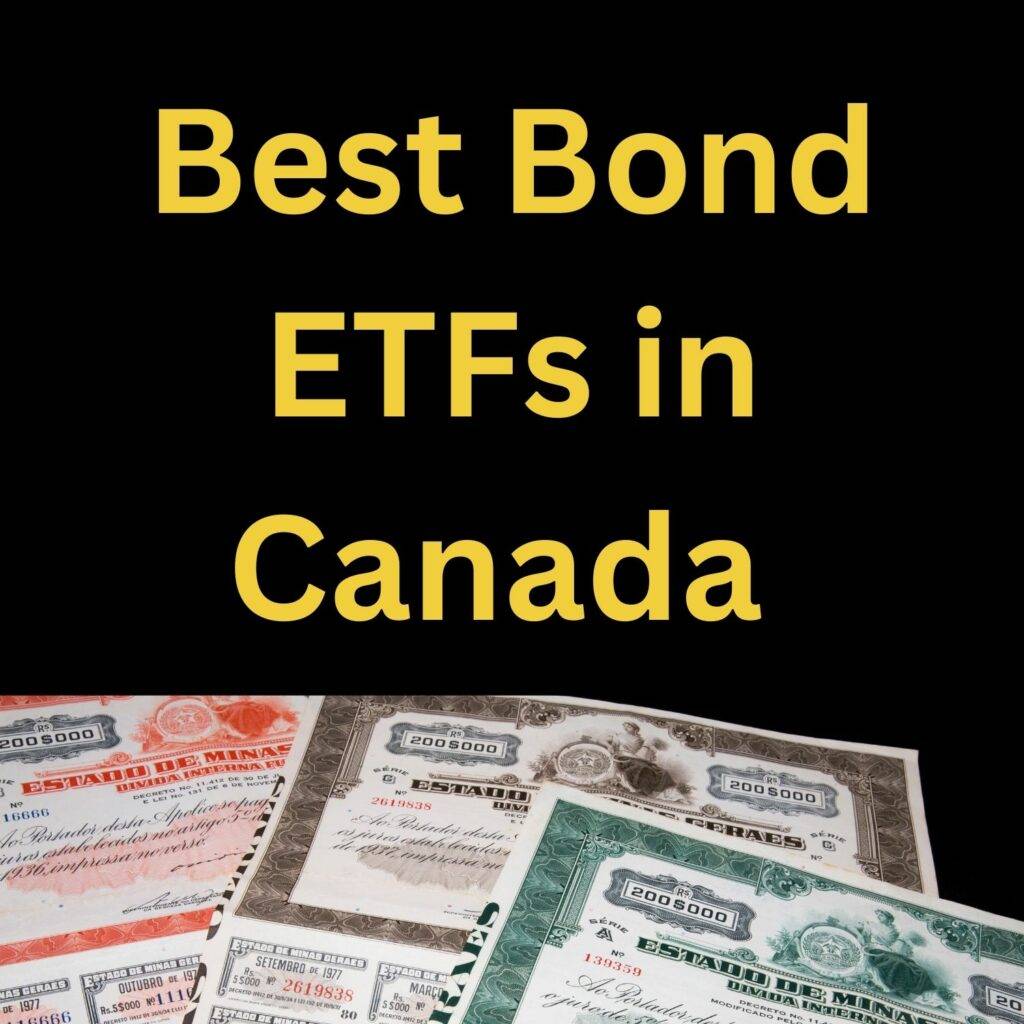What is a bond ETF?
In the world of Canadian income investing, a bond ETF takes center stage. This exchange-traded fund zeroes in on building a diverse portfolio of bonds. Picture bonds as IOUs—investors lending to governments or corporations. When you invest in a bond ETF, it’s like snagging shares of a fund that holds a mix of different bonds. In this post, we will cover all questions concerning Bond ETFs and present the Best Bond ETFs in Canada.

Why do income-focused investors love bond ETFs? Well, it’s all about the dual magic of income and diversification. These ETFs offer a ticket to a wide array of bonds, spreading the risk net across various issuers and maturity timelines. You can find bond ETFs tailoring their focus to different bond indices, whether it’s government bonds, corporate bonds, municipal bonds, or bonds with specific maturity ranges. Perfect for the savvy Canadian income investor looking to navigate the bond market without diving into individual bonds.
Review of HMAX: Hamilton Canadian Financials Yield Maximizer
Short term or Long term maturity Bond ETFs, which one to choose?
| Characteristic | Short Maturity Bond ETFs | Long Maturity Bond ETFs |
|---|---|---|
| Duration of Bonds | Typically 1 to 5 years | Often exceeds 10 years |
| Interest Rate Sensitivity | Less sensitive to rate changes | More sensitive to rate changes |
| Risk Profile | Lower risk, more stable | Higher risk, greater volatility |
| Income Yield | Lower yields | Higher yields |
| Investor Profile | Capital preservation, lower risk | Income-seeking, higher risk tolerance |
| Suitability in Rising Rates | Preferred due to lower sensitivity | May result in higher losses due to sensitivity |
Investors choose between short and long maturity bond ETFs based on their risk preferences, income needs, and views on interest rate movements. Short-term bonds offer stability and lower risk, while long-term bonds may provide higher yields but come with increased interest rate sensitivity.
Top Canadian bond ETFs
Top 5 Best Canadian REITs ETF in 2023
Best dividend stocks to buy – Dividend aristocrats 2023
Why Bond ETFs lost value in the past 2 years?
Bonds, essentially debt securities, are subject to market fluctuations, particularly in the face of changing interest rates. When interest rates rise, the prices of existing bonds tend to decrease. This is because newly issued bonds offer higher yields, making existing lower-yielding bonds less attractive. This price volatility can be unsettling for some investors.
However, the attractiveness of bonds lies in their regular interest payments, often referred to as coupon payments, and the promise of the return of the principal amount at maturity. These characteristics provide a level of stability and predictability, offering investors a stream of income and a known redemption value at the end of the bond’s term.
Now, enter bond exchange-traded funds (ETFs). These are investment funds that hold a portfolio of bonds, providing investors with a convenient way to gain exposure to the bond market. Bond ETFs offer several advantages, including low costs and diversification. The low costs result from the fund structure and the fact that ETFs typically track an index rather than relying on active management.
Diversification is another key benefit of bond ETFs. By holding a variety of bonds in their portfolio, these funds spread risk, reducing the impact of the poor performance of any single bond. This diversification can enhance the stability of returns compared to holding individual bonds.
However, it’s crucial to note that bond ETFs lack a maturity feature. Unlike holding an individual bond until maturity and receiving the principal amount back, ETFs do not have a fixed maturity date. This characteristic means that investors won’t necessarily receive the face value of the bonds in the ETF when they sell their shares.

Bond ETFs are particularly well-suited for long-term investors who are looking for a balance between regular income, potential capital appreciation, and a degree of risk mitigation through diversification. By providing exposure to a broad range of bonds, these ETFs can navigate various interest rate environments, potentially outperforming the returns of keeping funds in idle cash over the long term.
In essence, while individual bonds come with the promise of a fixed return of capital, bond ETFs offer a dynamic and diversified approach to bond investing, making them an attractive option for investors with a longer time horizon.
ZAG ETF Review – BMO Aggregate Bond Index
BMO Aggregate Bond Index ETF (ZAG) is a prominent player in the Canadian investment landscape, managing a substantial $6,279 million in assets. Renowned for its expansive size and liquidity, ZAG strategically allocates its holdings across Canadian federal and provincial government bonds, as well as investment-grade corporate bonds, providing investors with a broad market exposure.
With a targeted weighted average duration of approximately 7.4 years, ZAG exhibits a balanced strategy that considers potential returns while managing interest rate risk. The fund’s notable characteristics include a high dividend yield of 3.56% and an impressively low Management Expense Ratio (MER) of 0.09%, making it an attractive option for investors seeking both income generation and cost efficiency.
Underlining its commitment to quality, ZAG maintains an exceptional credit rating, with 89% of its assets invested in bonds rated A or better. Government entities dominate the fund’s portfolio, with the federal government representing 37% of assets and provincial governments at 34%. This strategic allocation contributes to the fund’s stability and reliability.
XBB ETF Review – iShares Core Canadian Universe Bond Index ETF
iShares Core Canadian Universe Bond Index ETF (XBB) tracks the FTSE Canada Universe Bond Index, offering a diverse portfolio of high-quality Canadian bonds. With a 7.5-year average duration, XBB has a slightly higher expense ratio than ZAG but maintains cost-effectiveness. Strong in credit quality, it yields 3.01%, ranking mid-tier among Canadian bond ETFs.
XBB shines in credit quality, allocating a significant 39% of assets to AAA-rated bonds.
VAB ETF Review – Vanguard Canadian Aggregate Bond Index ETF
Launched in 2011, the Vanguard Canadian Aggregate Bond Index ETF (VAB) is a standout in the Canadian bond market, amassing nearly $4 billion in assets. This ETF employs a passive strategy, tracking the Bloomberg Global Aggregate Canadian Float Adjusted Bond Index and investing in investment-grade bonds across Canada. What sets VAB apart is its low 0.09% Management Expense Ratio (MER), an impressive 3.55% distribution yield, and a commitment to excellent credit quality. Notably, VAB’s MER is tied for the lowest on this list. The fund’s weighted average duration aligns with its counterparts at 7.4 years, providing a balanced approach.

XSB ETF Review – iShares Core Canadian Short Term Bond Index ETF
iShares Core Canadian Short Term Bond Index ETF (XSB) excels as a Canadian bond ETF, tracking the FTSE Canada Short Term Overall Bond Index with a 3-year average maturity. Its short-term focus shields against losses in rising rates, evident in 2022. With a low 2.48% yield, XSB is a resilient, low-cost, and income-focused choice for long-term investors.
- Apple Q2 2025 Earnings: Dividend Raised, $110B Buyback, But China Weakness Raises Questions
- Alphabet (GOOGL) Q1 2025 Earnings: Cloud Profits, First Dividend, and What It Means for Canadian Investors
- QYLD ETF Review: Global X Nasdaq-100 Covered Call ETF
- Best Canadian Energy ETF – Top 5
- VFV vs XSP: Comparing Two Popular S&P 500 ETFs for Canadian Investors
Bond ETF Pros for Canadian Income Investors:
For income-focused investors in Canada, bond ETFs bring several advantages to the table. These pros encompass diversification benefits, enhanced liquidity, ease of trading on the Canadian stock exchanges, and potentially lower costs compared to managing individual bonds. Bond ETFs also provide a streamlined avenue to access various segments of the Canadian bond market, such as government, corporate, and municipal bonds. The transparency in ETF holdings and the ability to trade throughout the day align well with the preferences of income-seeking investors.
Bond ETF Cons for Canadian Income Investors:
While bond ETFs hold appeal, it’s imperative for Canadian income investors to be aware of potential drawbacks. These cons may involve sensitivity to interest rate fluctuations, impacting bond prices. Market volatility can also influence the value of the ETF. Notably, bond ETFs might not suit investors with specific needs tied to individual bond maturity dates. A thorough understanding of these cons is crucial for income investors in Canada to make informed decisions.
Should Canadian Income Investors Consider Bond ETFs?
Determining the suitability of bond ETFs for Canadian income investors hinges on factors like investment objectives, risk tolerance, and investment horizon. Bond ETFs can be an attractive option for those seeking income, diversification, and relative stability in their portfolios. However, considering Canada’s economic landscape, including interest rate expectations and market dynamics, is essential. Evaluating the pros and cons, within the context of individual circumstances, will guide Canadian income investors in deciding whether bond ETFs align with their income-focused investment strategy.
Last posts:
- Apple Q2 2025 Earnings: Dividend Raised, $110B Buyback, But China Weakness Raises Questions
- Alphabet (GOOGL) Q1 2025 Earnings: Cloud Profits, First Dividend, and What It Means for Canadian Investors
- QYLD ETF Review: Global X Nasdaq-100 Covered Call ETF
- Best Canadian Energy ETF – Top 5
- VFV vs XSP: Comparing Two Popular S&P 500 ETFs for Canadian Investors
- Review JEPQ: JPMorgan Nasdaq Equity Premium Income ETF
- Best US Dividend ETF in canada (2025)!
- Investment Savings Accounts: A Smart Way to Maximize Interest in Your Brokerage Account
- VUN vs VOO: A Comprehensive Guide for Canadian Investors to Maximize U.S. Market Exposure
- In-Depth Comparison: BTCC vs BTCX for Bitcoin Investment

